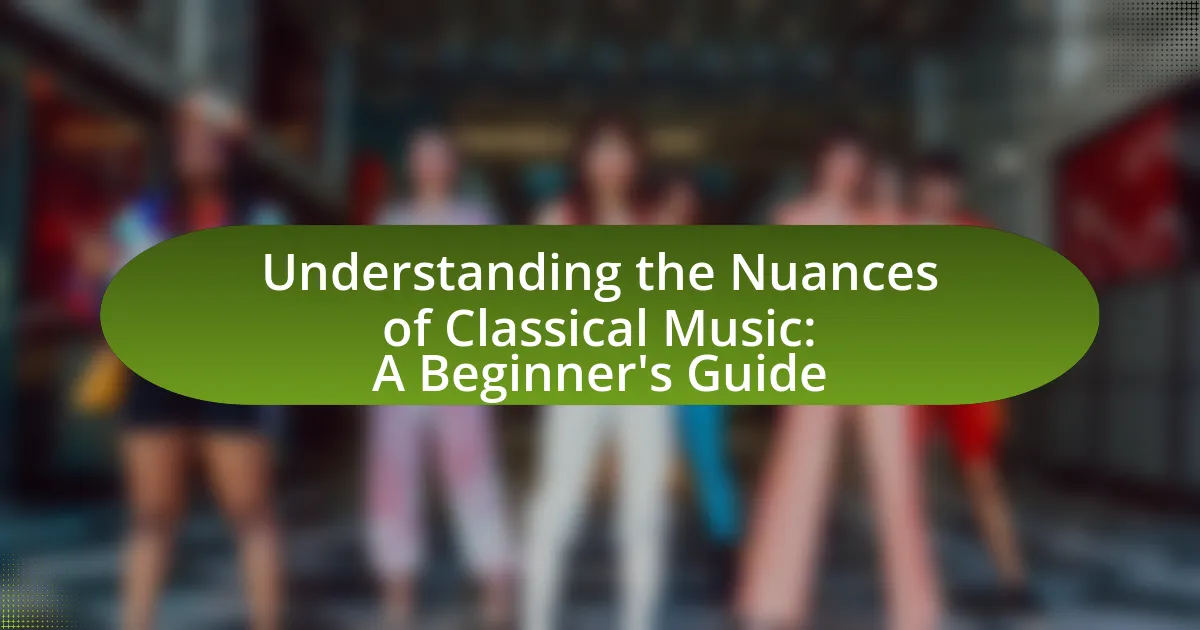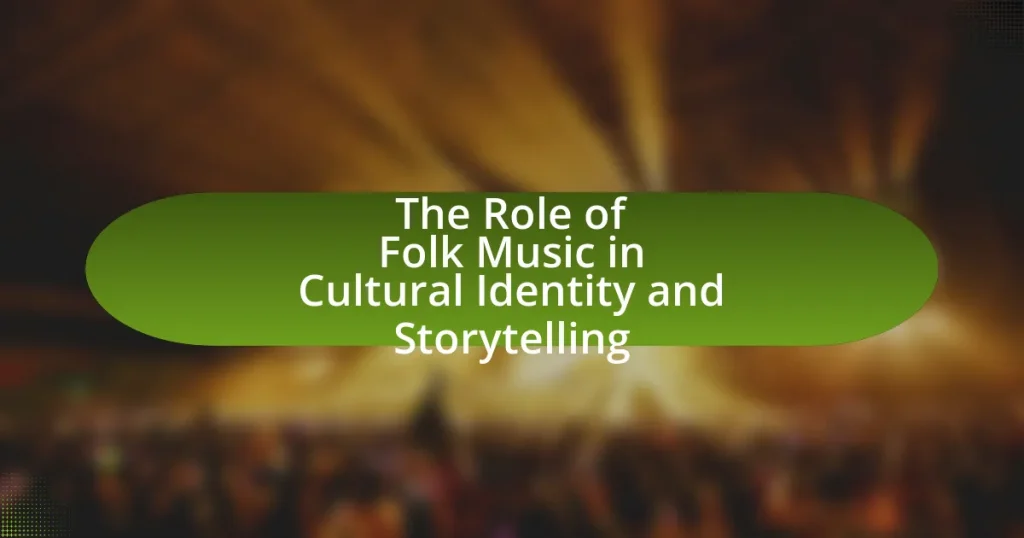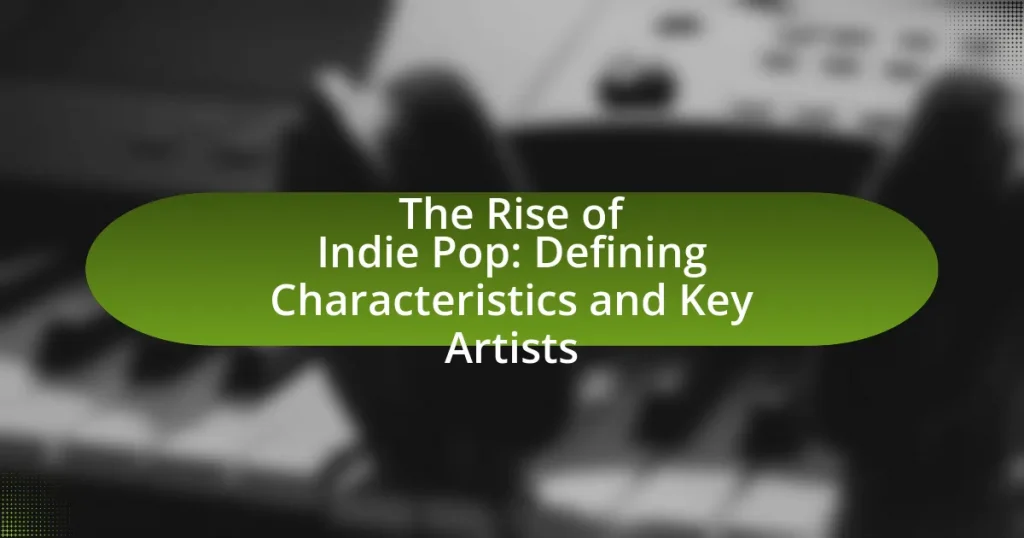The article “Understanding the Nuances of Classical Music: A Beginner’s Guide” provides a comprehensive overview of classical music, focusing on its key elements such as melody, harmony, rhythm, form, timbre, and dynamics. It explores the structural differences between classical music and other genres, detailing various forms like sonata, symphony, and concerto. The article also discusses the roles of different instruments in orchestras, the significance of historical context, and the contributions of notable composers. Additionally, it offers practical tips for beginners on how to appreciate classical music, including recommended pieces and resources for further learning.

What are the key elements of classical music?
The key elements of classical music include melody, harmony, rhythm, form, timbre, and dynamics. Melody refers to the main theme or tune of a piece, while harmony involves the combination of different musical notes played simultaneously to create chords. Rhythm is the pattern of sounds and silences in music, establishing the tempo and beat. Form describes the structure of a musical composition, such as sonata or symphony. Timbre, often referred to as the “color” of music, distinguishes different instruments and voices. Dynamics indicate the volume of music, ranging from soft to loud, affecting the emotional expression of a piece. These elements collectively define the complexity and richness of classical music, as evidenced by the works of composers like Bach, Mozart, and Beethoven, who skillfully employed these components to create enduring masterpieces.
How does the structure of classical music differ from other genres?
The structure of classical music is characterized by its use of formal compositional techniques, such as sonata form, rondo, and theme and variations, which differ significantly from the more flexible structures found in genres like pop or rock. Classical compositions often feature multiple movements, each with distinct themes and development sections, allowing for complex musical narratives, whereas other genres typically rely on repetitive verse-chorus forms. For example, sonata form, prevalent in classical music, consists of exposition, development, and recapitulation sections, providing a framework for thematic exploration that is less common in popular music, which often prioritizes catchy hooks and straightforward arrangements.
What are the main forms and structures found in classical music?
The main forms and structures found in classical music include sonata form, symphony, concerto, chamber music, and opera. Sonata form, characterized by its exposition, development, and recapitulation sections, serves as a foundational structure in many compositions. The symphony typically consists of multiple movements, often following a fast-slow-fast pattern, while the concerto features a solo instrument accompanied by an orchestra, highlighting the interplay between the two. Chamber music, designed for small ensembles, emphasizes intimate performance settings, and opera combines music, singing, and drama to tell a story. These forms have been utilized by composers throughout history, such as Beethoven and Mozart, to create diverse and complex musical works.
How do dynamics and tempo contribute to classical music’s uniqueness?
Dynamics and tempo are essential elements that contribute significantly to the uniqueness of classical music. Dynamics refer to the variations in loudness between notes or phrases, allowing composers to express a wide range of emotions and create dramatic contrasts within a piece. For instance, the use of crescendos and decrescendos can evoke feelings of tension and release, enhancing the listener’s emotional experience.
Tempo, on the other hand, pertains to the speed at which a piece is played, influencing the overall mood and character of the music. Different tempos can transform the same melody into a lively dance or a solemn reflection. For example, a fast tempo can create excitement and energy, while a slow tempo may convey introspection or melancholy.
The interplay between dynamics and tempo allows classical music to convey complex narratives and emotional depth, distinguishing it from other genres. Historical examples, such as Beethoven’s symphonies, showcase how these elements are meticulously crafted to enhance the storytelling aspect of the music, making it a unique art form.
What instruments are commonly used in classical music?
Common instruments used in classical music include the violin, cello, flute, clarinet, trumpet, and piano. These instruments are integral to orchestras and chamber ensembles, providing a wide range of tonal colors and dynamics. For instance, the violin is often featured as a lead instrument in orchestral settings, while the piano serves both as a solo instrument and an accompaniment in various compositions. The inclusion of these instruments is supported by their historical significance in classical compositions, with many works specifically written for them by renowned composers such as Mozart, Beethoven, and Tchaikovsky.
What are the roles of strings, woodwinds, brass, and percussion in orchestras?
Strings, woodwinds, brass, and percussion each play distinct roles in orchestras. Strings, including violins, violas, cellos, and double basses, provide the harmonic foundation and melodic lines, often carrying the main themes of a piece. Woodwinds, such as flutes, oboes, clarinets, and bassoons, add color and texture, often interweaving melodies and providing contrasting timbres. Brass instruments, including trumpets, trombones, French horns, and tubas, contribute power and brilliance, often used for fanfares and climactic moments. Percussion instruments, like timpani, snare drums, and cymbals, provide rhythm and accentuation, enhancing the overall dynamic range and adding dramatic effects. Each section’s unique sound and function contribute to the orchestra’s rich tapestry, creating a cohesive musical experience.
How do different instruments affect the overall sound of a classical piece?
Different instruments significantly affect the overall sound of a classical piece by contributing unique timbres, dynamics, and ranges. Each instrument, such as strings, woodwinds, brass, and percussion, has distinct acoustic properties that shape the texture and emotional character of the music. For example, string instruments like violins produce a warm, rich sound, while woodwinds like flutes offer a lighter, airy quality. Brass instruments, such as trumpets, add power and brilliance, and percussion instruments provide rhythm and depth. The combination of these varied sounds creates a complex auditory landscape, allowing composers to evoke specific moods and themes. Historical examples, such as Beethoven’s use of orchestration in his symphonies, illustrate how the interplay of different instruments can enhance the narrative and emotional impact of a classical work.
Why is historical context important in understanding classical music?
Historical context is crucial for understanding classical music because it provides insight into the cultural, social, and political influences that shaped the compositions and styles of different eras. For instance, the transition from the Baroque to the Classical period reflected changes in societal values, such as the rise of individualism and the Enlightenment’s emphasis on reason, which influenced composers like Mozart and Haydn. Additionally, understanding the historical context allows listeners to appreciate the intentions behind a piece, such as Beethoven’s works reflecting the turmoil of the Napoleonic Wars, thereby enriching the listening experience and fostering a deeper connection to the music.
How did different musical eras influence the development of classical music?
Different musical eras significantly influenced the development of classical music by introducing distinct styles, forms, and compositional techniques. The Medieval era established foundational elements such as notation and polyphony, which allowed for more complex musical structures. The Renaissance era expanded on these foundations by emphasizing harmony and the use of instruments, leading to richer textures in compositions. The Baroque period introduced ornamentation and the concept of contrast, exemplified by composers like Bach and Vivaldi, who utilized these techniques to enhance emotional expression. The Classical era further refined musical forms, emphasizing clarity and balance, as seen in the works of Mozart and Haydn, who developed sonata form and symphonic structure. The Romantic era shifted focus towards individual expression and emotional depth, with composers like Beethoven and Chopin pushing the boundaries of form and harmony. Each era contributed unique characteristics that collectively shaped the evolution of classical music, demonstrating a continuous dialogue between tradition and innovation.
What are the significant composers and their contributions to classical music?
Significant composers in classical music include Johann Sebastian Bach, Ludwig van Beethoven, and Wolfgang Amadeus Mozart, each contributing uniquely to the genre. Bach, known for his intricate counterpoint and harmonic innovations, composed works like “The Well-Tempered Clavier,” which laid the groundwork for future Western music theory. Beethoven revolutionized the symphonic form and expanded emotional expression in music, with masterpieces such as his Ninth Symphony, which introduced choral elements to the symphony. Mozart, celebrated for his melodic genius and operatic contributions, created iconic works like “The Magic Flute” and “Don Giovanni,” which showcased his ability to blend drama with music. These composers significantly shaped the evolution of classical music through their innovative techniques and enduring compositions.
How can one appreciate classical music more deeply?
To appreciate classical music more deeply, one should actively listen to various compositions while focusing on the structure, instrumentation, and emotional nuances. Engaging with the music by identifying themes, motifs, and the interplay between different instruments enhances understanding. Research indicates that active listening, which involves analyzing the dynamics and harmonies, can significantly improve one’s appreciation of the genre. For instance, a study published in the Journal of Music Theory by authors such as Allen Forte emphasizes that recognizing compositional techniques deepens emotional engagement and enjoyment.
What are some common misconceptions about classical music?
Common misconceptions about classical music include the belief that it is only for the elite or that it is boring and inaccessible. Many people think classical music is exclusively enjoyed by a wealthy or highly educated audience, but studies show that classical music appeals to a diverse range of listeners across various demographics. Additionally, the notion that classical music lacks excitement is inaccurate; numerous compositions are dynamic and emotionally engaging, with pieces like Stravinsky’s “The Rite of Spring” causing riots at its premiere in 1913 due to its innovative and provocative nature. These misconceptions often stem from cultural stereotypes and a lack of exposure to the genre’s rich variety.

What are the different styles within classical music?
The different styles within classical music include Baroque, Classical, Romantic, Impressionist, and Contemporary. Baroque music, characterized by complex polyphony and ornamentation, flourished from approximately 1600 to 1750, with composers like Johann Sebastian Bach and George Frideric Handel. The Classical style, emerging around 1750 to 1820, emphasized clarity and balance, exemplified by composers such as Wolfgang Amadeus Mozart and Joseph Haydn. The Romantic period, spanning from the early 19th century to the early 20th century, focused on emotional expression and individualism, with notable figures like Ludwig van Beethoven and Pyotr Ilyich Tchaikovsky. Impressionism, which developed in the late 19th century, sought to evoke moods and atmospheres, represented by composers like Claude Debussy. Finally, Contemporary classical music, from the mid-20th century to the present, encompasses a wide range of styles and techniques, reflecting modern influences and innovations. Each style is distinct in its characteristics and historical context, contributing to the rich tapestry of classical music.
How do Romantic, Baroque, and Classical styles differ from each other?
Romantic, Baroque, and Classical styles differ primarily in their emotional expression, structural complexity, and historical context. The Romantic style, emerging in the late 18th to early 19th centuries, emphasizes individual emotion and personal expression, often featuring expansive melodies and rich harmonies. In contrast, the Classical style, which flourished from the mid-18th to early 19th centuries, is characterized by clarity, balance, and formality, with structured forms such as sonatas and symphonies. The Baroque style, prevalent from the late 16th to the early 18th centuries, is known for its ornate detail, contrast, and use of counterpoint, often employing complex polyphony. Each style reflects its respective era’s cultural values and artistic priorities, with Romanticism focusing on emotion, Classicism on order, and Baroque on complexity.
What are the defining characteristics of the Romantic style?
The defining characteristics of the Romantic style in classical music include emotional expressiveness, individualism, and a focus on nature and the supernatural. This style emerged in the late 18th century and flourished throughout the 19th century, characterized by composers like Franz Schubert, Johannes Brahms, and Pyotr Ilyich Tchaikovsky. Emotional expressiveness is evident in the use of rich harmonies and dynamic contrasts, allowing composers to convey deep feelings and moods. Individualism is reflected in the unique styles and personal voices of composers, often breaking away from traditional forms and structures. Additionally, the Romantic style frequently incorporates themes of nature and the supernatural, as seen in works inspired by landscapes, folklore, and mythology, which further enhances the emotional depth and narrative quality of the music.
How did the Baroque period shape the evolution of classical music?
The Baroque period significantly shaped the evolution of classical music by introducing complex musical forms, ornamentation, and the use of contrast in dynamics and texture. Composers like Johann Sebastian Bach and George Frideric Handel developed the concerto, sonata, and opera, which became foundational genres in classical music. The period also emphasized the use of basso continuo, a form of musical accompaniment that influenced harmonic structure. Additionally, the Baroque era’s focus on emotional expression and the use of counterpoint laid the groundwork for the Classical period’s development, leading to more structured forms and clearer melodies.
What role does improvisation play in classical music?
Improvisation plays a significant role in classical music, particularly in the context of historical performance practices and the development of musical ideas. Historically, many composers, such as Johann Sebastian Bach and Wolfgang Amadeus Mozart, incorporated improvisation into their performances, allowing musicians to express creativity and spontaneity within the framework of their compositions. This practice was essential during the Baroque and Classical periods, where performers were often expected to embellish melodies and create variations on the spot. The ability to improvise not only showcases a musician’s technical skill but also enhances their interpretative depth, making performances more dynamic and engaging.
How does improvisation differ between classical and other music genres?
Improvisation in classical music is typically more structured and follows established forms and harmonic progressions, while in genres like jazz or rock, it often emphasizes spontaneity and personal expression. Classical musicians usually improvise within the confines of a specific style or set of rules, as seen in the works of composers like Bach, who incorporated improvisational elements in their performances but adhered to classical forms. In contrast, jazz musicians frequently create solos that are free from strict adherence to predetermined structures, allowing for greater individual creativity and interaction with other musicians. This distinction highlights the varying approaches to improvisation across different music genres.
What are some famous examples of improvisation in classical music?
Famous examples of improvisation in classical music include the works of composers such as Johann Sebastian Bach, Wolfgang Amadeus Mozart, and Franz Liszt. Bach was known for his ability to improvise complex fugues and chorales during performances, showcasing his mastery of counterpoint. Mozart frequently improvised during concerts, often creating variations on his own themes, which demonstrated his exceptional skill and creativity. Liszt, renowned for his virtuosic piano performances, often included improvisational sections in his recitals, captivating audiences with spontaneous compositions. These instances highlight the significance of improvisation in the classical tradition, reflecting the composers’ deep understanding of musical structure and their ability to engage with their audience in real-time.

How can beginners get started with classical music?
Beginners can get started with classical music by exploring a variety of compositions and listening to different styles. Engaging with iconic pieces from composers like Bach, Mozart, and Beethoven provides a solid foundation. Listening to curated playlists or attending live performances can enhance understanding and appreciation. Additionally, utilizing resources such as music apps, online courses, or local music classes can offer structured learning. Research indicates that exposure to classical music can improve cognitive skills and emotional well-being, making it beneficial for beginners to immerse themselves in this genre.
What are some recommended pieces for classical music newcomers?
Recommended pieces for classical music newcomers include Beethoven’s Symphony No. 9, Tchaikovsky’s Swan Lake, and Bach’s Brandenburg Concerto No. 3. These works are widely recognized for their emotional depth and musical innovation, making them accessible and engaging for beginners. Beethoven’s Symphony No. 9 features the famous “Ode to Joy,” which is celebrated for its uplifting themes. Tchaikovsky’s Swan Lake is a quintessential ballet score that showcases beautiful melodies and orchestration. Bach’s Brandenburg Concerto No. 3 exemplifies the Baroque style with its intricate counterpoint and lively rhythms. These pieces serve as an excellent introduction to the diverse world of classical music.
How can one create a balanced listening experience with classical music?
To create a balanced listening experience with classical music, one should select a diverse range of compositions that include various styles, periods, and instrumentation. This approach ensures exposure to different emotional expressions and technical complexities, enhancing overall appreciation. For instance, incorporating works from Baroque, Classical, Romantic, and Contemporary periods allows listeners to experience the evolution of musical forms and ideas. Additionally, varying the tempo and dynamics within the selected pieces can create a more engaging auditory experience. Research indicates that a well-rounded selection can improve cognitive engagement and emotional response, as demonstrated in studies on music perception and enjoyment.
What resources are available for learning about classical music?
Resources available for learning about classical music include online courses, books, and music streaming services. Online platforms like Coursera and edX offer courses on classical music history and appreciation, often created by reputable institutions such as Yale University. Books such as “The Lives of the Great Composers” by Harold C. Schonberg provide in-depth insights into composers and their works. Additionally, music streaming services like Spotify and Apple Music feature curated classical playlists and educational podcasts that enhance understanding of the genre. These resources collectively support a comprehensive learning experience for beginners interested in classical music.
What tips can help enhance the listening experience of classical music?
To enhance the listening experience of classical music, listeners should focus on creating an optimal environment, actively engaging with the music, and utilizing resources for deeper understanding. Establishing a quiet space free from distractions allows for better concentration on the intricate details of the compositions. Engaging actively involves listening for specific elements such as instrumentation, dynamics, and thematic development, which can deepen appreciation. Additionally, utilizing resources like program notes or educational materials can provide context about the piece and its composer, enriching the overall experience. Research indicates that active listening and contextual knowledge significantly improve musical enjoyment and comprehension.
How can one develop a personal connection to classical music?
To develop a personal connection to classical music, one should actively listen to a variety of compositions and explore the emotions they evoke. Engaging with different styles, such as Baroque, Romantic, or Contemporary, allows individuals to discover personal preferences and resonate with specific pieces. Research indicates that emotional engagement with music can enhance personal connections; for instance, a study published in the journal “Psychology of Music” by Gabrielsson and Lindström (2001) found that listeners often form strong emotional bonds with music that reflects their personal experiences. Additionally, attending live performances can deepen this connection, as the atmosphere and energy of a concert create a unique experience that recorded music cannot replicate.



